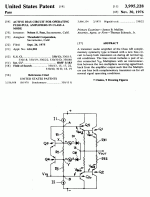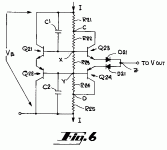Here's what I found in the ML33.@IanHegglun
Hans Polak shared ML33 adaptive bias in The Black Hole... #8472. Seems operable without thermal compensation and simpler than #167.
There is a significant change in bias current when the temperature of the power transistors heat up. Going from 27C to 77C the idle current changes from 100mA (my choice) to 232mA, see plot below, and still needs thermal feedback to stabilize the idle current.
(I chose 100mA by changing P1 to 33k - I wanted to see if there was an optimum bias, where the crossover gain wobble dipped down, white plot, but it doesn't, instead the bias loop breaks up (at high swing) if the idle current goes under 90mA).
There is an increase in bias current when the temperature of the power transistors heat up because the power transistor b-e junction is outside the bias loop Q3,Q4,M1,M2,D1,D2. The ML33 is similar to the Tanaka AES 3/81 circuit - the main operational difference being D1,D1 carry most of the current of M1 and M2 and bias adjustment uses P1 on the bases of Q3,Q4. The Tanaka also has the power transistor b-e junction outside the bias loop and therefore needs thermal feedback to stabilize the idle current.
However, if the ambient temperature is increased and the power transistors also increase by the same ambient change, then there is a very slight drop in idle current of 1mA for a 10C ambient increase
The attached file includes MOSFET models with tempco's. Notice the MOSFETs are inside the bias loop so they are not sensitive to their temperature changes.
@ Nelson. Thanks for your circuit. It appears there is no feedback of driver transistors in yours, like the Tanaka and ML33.
Attachments
I am using optocoupler VOS617 150khz BW to feedback the bias measured by two diodes and resistors similar the output in post 167. In my circuit it keeps non switched and autobiased at 200ma to run the non degenerated common source MOSFETS at 200ma in class B. The 6N136 is 600khz but it needs 5v supply.
That is actually pretty good.Going from 27C to 77C the idle current changes from 100mA (my choice) to 232mA, see plot below, and still needs thermal feedback to stabilize the idle current.
I am coming to the conclusion that optimum bias for minimal distortion is important only for low-feedback amplifiers. A high-feedback amplifier can easily hide the 4x increase in distortion due to the bias drifting from optimal to too high.
Thermal runaway is even less problematic. There is an order of magnitude ratio between the bias being too low and causing crossover distortion, to the bias being too high and increasing the maximum dissipation. This is a big enough range that amplifiers can tolerate some variation.
Ed
Re Thermal runaway in circuit post #183?
I didn't mention it, but the circuit simulated in Post 183 is isothermal, which means temperatures are held constant during each step of a run. What happens in a real amp is the heatsink warms up and the temperature, when left at idle, reaches some final value which depends on the bias' temperature coefficient and the heatsink thermal resistance to ambient. None of this is simulated in Post 183, so you can't say if thermal runaway is going to happen when as stated the idle current goes from 100mA to 232mA for a junction temperature change of 27C to 77C. It all depends on the thermal equivalent circuit for the power transistors. I agree Indra1, given a hefty enough heatsink it should not have thermal runaway even with no thermal feedback to the bias loop (eg Q3,Q4). To simulate thermal runaway you need to use electrothermal models but then they need calibration against bench tests so I find it easier just to do bench tests.
I didn't mention it, but the circuit simulated in Post 183 is isothermal, which means temperatures are held constant during each step of a run. What happens in a real amp is the heatsink warms up and the temperature, when left at idle, reaches some final value which depends on the bias' temperature coefficient and the heatsink thermal resistance to ambient. None of this is simulated in Post 183, so you can't say if thermal runaway is going to happen when as stated the idle current goes from 100mA to 232mA for a junction temperature change of 27C to 77C. It all depends on the thermal equivalent circuit for the power transistors. I agree Indra1, given a hefty enough heatsink it should not have thermal runaway even with no thermal feedback to the bias loop (eg Q3,Q4). To simulate thermal runaway you need to use electrothermal models but then they need calibration against bench tests so I find it easier just to do bench tests.
I wrote both distortion and thermal simulators for my amplifier's output stage. That is why I know so much about my amplifier. 
The distortion simulator should be highly accurate being based on Ebers-Moll. The thermal simulator is more approximate since I don't know the exact thermal resistance of the heatsinks. The numbers I quoted are ballpark figures when applied to other amplifiers.
Ed
The distortion simulator should be highly accurate being based on Ebers-Moll. The thermal simulator is more approximate since I don't know the exact thermal resistance of the heatsinks. The numbers I quoted are ballpark figures when applied to other amplifiers.
Ed
Hi EdGr,
As for the level of THD, I don't get worried by it like in Post 38 here by GedLee https://www.diyaudio.com/community/...istortion-speaker-drivers.294787/post-4787082
I agree. The ML33 distortion change with bias change is pretty remarkable in that it is almost nonexistant provided the idle current is over some (relatively low) idle current, here 90mA and over. The distortion in the crossover region is from the bump around the zero crossing (White plot in #183). What is remarkable is this gain variation doesn't change much if idle current is altered from 100mA and above, unlike the standard wingspread plots of BJT and MOSFET output stages. I think this is a significant step forward in power amplifier output stages and deserves a section in a manual like those from Bob Cordell and Douglas Self and the like.That is actually pretty good...I am coming to the conclusion that optimum bias for minimal distortion is important only for low-feedback amplifiers. A high-feedback amplifier can easily hide the 4x increase in distortion due to the bias drifting from optimal to too high.
As for the level of THD, I don't get worried by it like in Post 38 here by GedLee https://www.diyaudio.com/community/...istortion-speaker-drivers.294787/post-4787082
And he is an authority in audio! (More here and interview transcript Post 6). Here's how I interpret distortion in my amp testing (Post 157) https://www.diyaudio.com/community/...ching-auto-bias-power-amp.375141/post-7039868."Basically any discussion of THD in loudspeakers or amps or anything is pointless as these numbers do not mean anything."
Doug Self's 6th edition pp. 91-99 told stories (but no analysis) about non switching of 1976-1995 including Tanaka's. Doug was unimpressed.deserves a section in a manual like those from Bob Cordell and Douglas Self and the like.
Hi Ed,Your amplifier is unusual. I think that you need to work on eliminating the floating supply and reducing THD by 20dB.
Ed
Here's a way to make it autobias with a non-floating power supply:
The Schottky diodes are now connected to the rails, with Q6,Q7 as shifting their voltages to autobias transistors Q3,Q4. The output stage gain from 'in1' is about 50. The input stage has a gain of about 10 for extra feedback and soft clip. The FFT for 100W below:
3rd harmonic is -60dB which is I find inaudible, and with -50dB/decade roll off the higher harmonics are falling fast enough to remain inaudible. What I have found more significant than harmonic distortion levels below these is for the power amp to have soft clipping and clean recovery.
An additional benefit of this input stage is the clip level can be reduced by increasing R29, eg with a PTC thermistor, which can allow heatsink over-temperature dynamic limiting without shutting down altogether and making a very robust amplifier. The clip is shown below:
Clip is setup here to begins at 200W peak (100W average) and is nice and rounded above 100W. The amount of feedback in the output stage determines the start point for this clip, set by R3,R4.
As for thermal effects of bias shift from using Schottky diodes for sensing the output stage current, this can be cancelled by thermal linkage of D1 to Q6 also D2 to Q5. The plot below shows no linkage and then with linking both for a 10 deg.C change in diode temperature:
Ian
Attachments
Ian, have you already explained why you prefer generic small signal transistor models (e.g. "Q3 NPN" , "Q4 PNP") rather than fitted-from-measuring-real-devices-in-real-life models ("2N5551C" , "2N5401C") such as the ones Bob Cordell has lovingly created (here)? Would you please mention the post # that discuss this? Thank you!!
The new design is more practical.Here's a way to make it autobias with a non-floating power supply:
Why do you want soft clipping? 100W is well beyond what is needed for home use.
Ed
Hi Mark,Ian, have you already explained why you prefer generic small signal transistor models (e.g. "Q3 NPN" , "Q4 PNP") rather than fitted-from-measuring-real-devices-in-real-life models ("2N5551C" , "2N5401C") such as the ones Bob Cordell has lovingly created (here)? Would you please mention the post # that discuss this? Thank you!!
My bad
Hi Mark,
Here's the circuit with real BJT models (eg CZT5551/5401 for above 40V rails):

It requires phase advance capacitors to stop it oscillating with real BJT models, since there are extra HF nodes compared to my generic BJT models. Bench tests are needed to see if it can be stabilized in practice. So I prefer the floating supply version for this reason - it doesn't oscillate on the bench without adding capacitors. So it's a trade-off between a non-floating PS for convenience and floating PS with simplicity and stability.
Perhaps a better option is shown here? https://www.diyaudio.com/community/...other-rail-to-rail-output.325128/post-5491858 with less HF nodes.
Cheers, IanH
Here's the circuit with real BJT models (eg CZT5551/5401 for above 40V rails):
It requires phase advance capacitors to stop it oscillating with real BJT models, since there are extra HF nodes compared to my generic BJT models. Bench tests are needed to see if it can be stabilized in practice. So I prefer the floating supply version for this reason - it doesn't oscillate on the bench without adding capacitors. So it's a trade-off between a non-floating PS for convenience and floating PS with simplicity and stability.
Perhaps a better option is shown here? https://www.diyaudio.com/community/...other-rail-to-rail-output.325128/post-5491858 with less HF nodes.
Cheers, IanH
Attachments
I couldn't get the circuit in the link to work as autobias, so I modified it, then added the soft clip input stage:Perhaps a better option is shown here? https://www.diyaudio.com/community/...other-rail-to-rail-output.325128/post-5491858 with less HF nodes.
The distortion is about the same as the previous one but the bw is about 10 times higher (due to higher currents in the autobias loop). So a buffer is needed with the U04 array to drive 5mA peak since a U04 gives 1mA peak. Alt, a pair of FDC6320's could give the 5mA without a buffer but it is now EOL, so the FDC6321 can be used. Thermal feedback from the Schottkys is to Q1,Q2.
Attachments
Last edited:
- Home
- Amplifiers
- Solid State
- Towards a wideband non switching Auto Bias power amp

